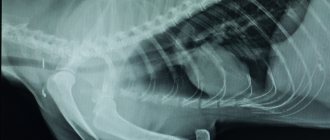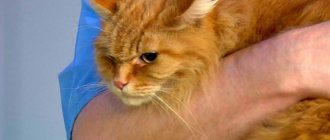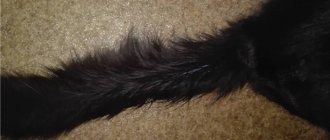The tail is an organ that is quite important for cats. And although they do not use it to climb trees, like monkeys, this organ is used to maintain balance and to convey their mood. Experienced cat lovers know very well that the position and appearance of the tail can tell a lot about the pet’s mood and intentions. So a fracture of a cat’s tail is not the most serious pathology, but it still needs to be treated quickly, without waiting for the organ to take on the appearance of an old poker.
Why is a tail fracture dangerous?
Tail injuries are common in cats that are regularly outdoors. These are the results of encounters with cars and bicycles, fights with other animals, and tail getting caught in doors... In short, there are a lot of possible reasons.
If your pet is lucky, he will get away with a slightly damaged tail; in other cases, the cat may be left without it altogether... It all depends on the strength of the traumatic factor. Unfortunately, tail injuries are not as harmless as people think. In some cases, they are fraught with the development of quite serious consequences, so that the injured pet must be shown to a veterinarian in any case.
Contrary to popular belief, the tail does not contain a spinal cord . It generally ends in the sacral spine, and therefore tail injuries do not affect it in any way. The fact is that the canal passing inside the caudal vertebrae still communicates with the common spinal vertebrae. This means that with an open fracture of the tail, complicated by inflammatory phenomena, the infection may well penetrate directly into the spinal cord, which is already fraught with paralysis and other negative phenomena, even death. But this is not the only problem.
Complications associated with nerve cord damage
When tail fractures are located closer to its root (directly at the sacrum), the soft tissues surrounding the rectum are often damaged. A nerve rupture can be complete or partial, and the further prognosis and prospects for a complete recovery of the animal depend on this.
Let's look at a simple classification of these phenomena:
- Neuropraxia . In this case, the sensitivity of the posterior areas is usually preserved, which allows us to hope for a complete recovery of the animal in the future. It usually takes about a month to finalize a forecast for a particular animal.
- Axonotmesis . This is an even milder injury, characterized by partial destruction of the myelin sheath of the nerve cord. After 10-14 days it usually recovers, the prognosis is good, all nerve functions return completely.
With complete anatomical “separation” of the caudal nerve cords as a result of serious fractures of the tail, there is no need to talk about a complete recovery.
Alas, in this case the owner will have to constantly take care of the cat, which cannot control the process of urination and defecation. This is not an easy task and requires considerable patience.
The genital area needs to be washed and cleaned daily. A catheter must be inserted into the bladder to empty it at least three times a day. Please note that this condition is fraught with chronic cystitis, nephritis and pyelonephritis. Constant veterinary supervision is required.
How to care for and treat a cat with complications?
In such cases, home treatment involves helping an animal that cannot urinate or defecate on its own. Such pets are prone to constipation, and therefore they will need products that soften the stool and facilitate its passage through the final segments of the large intestine. You can use regular oils and give your pet more moist, soft food. In other cases, they use lactulose contained in special commercial feeds.
If a cat cannot urinate on its own, a permanent catheter is “implanted” into its bladder, since its daily installation is fraught with infections of the genitourinary system. But in some cases, you can only get by with drug treatment to help the animal independently urinate and defecate. Let's take a closer look at some of these drugs:
- Bethanechol . Given two to three times a day, it is necessary to increase the rigidity of the bladder walls.
- Phenylpropanolamine and diethylstilbestrol are drugs that strengthen the urethral sphincter. Their dosage and procedure for use are established by the treating veterinarian depending on the specific case.
- Phenoxybenzamine, diazepam and flavoxate, on the contrary, relieve spasm of smooth muscles and help the cat to urinate naturally.
If there is no hope for complete restoration of bladder function, a course of antibiotics and other antimicrobial drugs to help cope with infections of the genitourinary system is indicated. hexamethylenetetramine , has worked well .
It increases the “antiseptic” properties of urine, which makes it possible to do without antibiotics.
Common causes of fractures
A cat's tail is an anatomical extension of the spine, so any damage can lead to serious consequences for the entire body. Most often, the animal is injured at home. For example, if there are small children in the house, then the likelihood of damage increases (dangerous games, tail pulling, etc.).
That is why it is necessary to explain to young children that they are putting the cat in danger by handling it carelessly. Sometimes even simple pranks that seem completely harmless can lead to serious damage to the animal.
Other causes of tail fractures in cats:
- being jammed by a door,
- accidental collision (for example, by a vehicle or bicycle),
- pulling with force,
- falling from a great height,
- attack on the tail,
- other mechanical damage to the lower back or tail itself.
Diagnosis of tail fractures
As a rule, diagnosing a tail fracture is quite simple: dislocations of this organ do not exist in nature, so if it deviates from its axis at some clearly abnormal angle, there is no need to doubt the nature of the pathology. The symptoms are quite obvious. Much more important is a neurological examination to show whether the caudal nerve cords are damaged (fortunately, this is extremely rare in practice).
The veterinarian will perform routine palpation to determine the exact location of the fracture. If the latter is open and fragments of crushed vertebrae are clearly visible in the wound, diagnosis is even more simplified.
In more doubtful cases, they resort to radiography, but not only of the tail... If the injury occurred as a result of a critically strong mechanical impact, it is necessary to make sure that the animal has no further damage.
In particular, it is advisable to do fluoroscopy and ultrasound of the chest, abdominal and pelvic cavities to exclude/confirm the presence of ruptures of internal organs . Of course, if the cat’s tail was simply “squashed” by a door that closed at the wrong time, such “difficulties” are not resorted to, since in these cases everything is already quite obvious.
How to distinguish a fracture from a tail bruise
In practice, tail bruises are extremely rare. The tail vertebrae are quite delicate and fragile, and therefore they break easily under strong mechanical stress. The organ itself is thin and flexible, and it is not easy to bruise it.
The tail is not a very “voluminous” organ; in case of fractures, it is easy to notice its strong curvature. Often a broken ponytail is shaped more like a poker. This does not happen with bruises.
When palpating, it is easy to feel areas where the vertebrae are crushed or severely diverged. During the examination, the animal becomes very nervous and screams in pain. With bruises, such severe pain usually does not occur.
Symptoms: how to determine if there is a problem
The cat has a swollen paw and is limping: what to do?
The fact that something is wrong with a cat’s tail will be visible to the naked eye. A crease or unnatural bend will be visible at the site of injury. Also, often when injuries occur, the innervation is disrupted, and the animal is unable to move the injured part.
The main signs of possible problems with a cat's tail are:
- visually noticeable fracture or disruption of integrity;
- pain when trying to touch the animal;
- traces of a bite, injury or infection are visible on the tail;
- a clearly noticeable inflammatory process and an increase in temperature, which can be detected even with a simple touch;
- the damaged part of the tail swells and swells;
- the tail hangs unnaturally;
- an open injury in which the bones are gaping;
- ensuing paralysis;
- problems with motor function of the legs are noticeable;
- problems with the toilet (either urinary and fecal incontinence appears, or the cat cannot defecate on its own).
An examination by a specialist will help you understand whether there is a fracture or whether it is a simple bruise.
Fracture of the sacrum in a cat
One of the most serious injuries in a cat is a sacral fracture . This condition is extremely dangerous, because... The spinal cord runs through the sacrum (as opposed to the tail).
A sacral fracture is fraught with damage to the nerve trunk and the development of the following symptoms:
- In severe fractures, when the spinal cord is torn by bone fragments, the cat's tail and hind limbs are completely lost. The animal cannot pee and poop “consciously”; the bladder and intestines are emptied at random times. In some cases, the pet dies from rupture of these organs, as normal bowel movements and urination cease completely.
- In milder cases, the tail sag like a whip, the cat drags its hind legs, and involuntary bowel movements and urination are often observed.
Prevention
Experts recommend the following rules for preventing injuries to the tail vertebrae in domestic cats:
- Be careful when handling the animal, do not pull or catch the cat by the tail.
- Limit your pet's access to the street.
- Have a conversation with the children about the importance of a cat’s tail and the inadmissibility of pranks on the animal.
- Provide heavy doors with a soft closing mechanism.
- Prevent the animal from jumping and falling from a height.
Fractures and other injuries to the tail of furry pets are not uncommon. Characteristic signs allow owners to accurately identify injury to the tail vertebrae. A timely contact with a veterinarian will allow you to provide the animal with qualified assistance with the least damage to health.
Similar articles
- The cat is limping on a paw (back or front), paw...
The causes of sudden lameness in a pet are most often injuries such as bruises, dislocations, sprains and torn ligaments. ... Tail fracture in cats and cats: symptoms and treatment. Read more - Cat tangles: how to get rid of them and avoid recurrence
Tail fracture in cats and cats: symptoms and treatment. How to prepare a cat for castration. Marina (content manager). Read more
- The cat scratched its ear until it bled: what to do if it itches...
All Diseases and ailments Kidney and intestinal diseases Internal diseases Parasites and fungus Injuries and surgeries Interesting things about cats Maintenance and care Obstetrics ... Tail fracture in a cat: symptoms and treatment. Marina (content manager). Read more
- The cat’s tumor has opened or burst, broken through...
All Diseases and ailments Kidney and intestinal diseases Internal diseases Parasites and fungus Injuries and surgeries Interesting things about cats Maintenance and care Obstetrics ... Tail fracture in a cat: symptoms and treatment. Marina (content manager). Read more
- How to remove a catheter from a cat and install a new one, how long does it...
All Diseases and ailments Kidney and intestinal diseases Internal diseases Parasites and fungus Injuries and surgeries Interesting things about cats Maintenance and care... To prevent loss, the catheter is attached to the pet's tail in this way... Read more
Treatment
It all depends on the characteristics of the injury and the condition of the pet. If, after a severe “root” fracture of the tail, the cat cannot control urination and defecation, everything is not too good (as we already wrote about above). However, most often, injuries to the tail, including its fractures, are treated quite simply (although full mobility of the organ is not always restored).
In case of open fractures of the tail , surgical treatment of the wound is performed, small fragments of bones, fur and other contaminants are removed from the canal. This is first aid. It is recommended to apply plates and staples to the vertebrae, which reduce the mobility of the tail and accelerate the process of healing of cracks and chips. If the tail is literally broken to such an extent that the affected part is supported by the remains of blood vessels and skin, its complete amputation .
For closed tail fractures, splints or pressure bandages are applied to the organ, immobilizing the organ and also accelerating the healing process.
As with any other type of fracture, the cat must be limited in its movements as much as possible during the recovery period. To do this, you can use special portable cages or ordinary baskets. This will allow the bone tissue to recover faster and prevent possible damage to the nerve cords. When amputating the tail, there is no need for such strict measures. In addition, it is necessary to inspect the splints and bandages daily: they should not contain blood, exudate, or other signs of the inflammatory process.
Daily treatment of the post-operative wound with antiseptic solutions may be required (in consultation with your veterinarian). Within about 10-14 days, complete fusion of the bone tissue of the tail occurs (under ideal conditions). Once again we warn owners of sick animals that the original mobility of the organ, as a rule, is no longer restored. A tubercle, a bend, and other traces of injury remain on the tail.
Types of injuries and causes
Owners most often associate a cat's tail injury with a bruise. The bruise goes away on its own and often goes unnoticed. But a fracture is also a fairly common problem in cats; its course is much more complicated.
Veterinarians classify tail fractures into 3 types.:
- Open – when there is tissue damage. This results in an open wound from which parts of the vertebrae of the organ protrude.
- Closed - in this case there are no visible damage to the skin, only a slight bend or break is visible.
- Fracture of the vertebrae - occurs if the injury occurs in a young individual. Bones are not completely destroyed because the skeletal system is not yet strong and has not matured enough.
© shutterstock
The most common causes of fractures and other injuries to the tail are:
- damage during a fight with other cats;
- animal bites;
- getting into an accident;
- if someone accidentally stepped on it;
- being hit by a car;
- strong compression;
- strong twitching;
- falling from height.
Home care for a sick pet
No special care measures are required, but the cat is physically unable to lift its tail, “shackled” in plaster, when visiting its litter box. This means that you will have to clean it daily. If you have such an opportunity, the “posterior regions” of your pet should be washed daily with warm water and baby soap (but the plaster cast should not get wet).
It is recommended to repeat x-rays approximately every two weeks to assess the speed and success of the regeneration processes. When bandages, splints, staples, etc. are removed, it is advisable to massage the affected tail daily. This will quickly restore the sensitivity of the organ and its flexibility.
A relatively “harmless” tail fracture is a fairly serious injury. The sooner you contact your veterinarian and begin treatment, the less likely you are to develop severe complications.











